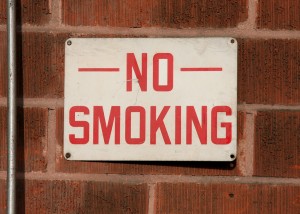Children are central. The vast majority of people who use tobacco take up the habit as teenagers, and one-third of kids who smoke daily will eventually die prematurely of tobacco-related illnesses, according to the Campaign for Tobacco Free Kids.
The health impact of obesity is similar: seriously overweight children are at greater risk of developing a multitude of health problems that can continue through adulthood, including diabetes, liver disease, heart disease, joint problems and asthma, and are more likely to become obese adults, a wide body of research has demonstrated.
Preventing harm to young people is a central goal of both anti-tobacco and anti-obesity campaigns.
Changing social norms is the goal. Dr. Jeffrey Koplan, former head of the CDC and vice president for global health at Emory University in Atlanta, remembers smoking a pipe while writing up patient notes at a prestigious New York hospital in the 1970s. (He gave up the habit more than 30 years ago.)
Today, that would be inconceivable: Smoking rates have been cut by more than half, intolerance of smoking in public places is widespread and anti-smoking policies are in place at hospitals, workplaces, and venues across the country.
Koplan is convinced the same shift in social norms is called for -- and achievable -- when it comes to childhood obesity. "Our (eating and physical activity) tastes, our preferences and our behaviors are learned and can be changed," he said. It isn’t going to be easy and it isn’t going to be fast, but "we’re dealing with a population that would like to be thinner and that works in our favor," he said.
We can’t just say no to food. "Tobacco we can get rid of entirely. ... But we have to eat to live and make terms with food as the enemy," said Dr. David Katz, director of Yale University’s Prevention Research Center.
That makes curbing childhood obesity a much more complicated issue than tobacco use, Katz and other experts agree. The message to kids and their families can’t be "stop, don’t do this," which is clear and easy to understand. Instead it has to be "make good choices, do this in moderation, set boundaries," a message that is considerably more difficult to convey.
There is no second-hand smoke equivalent. The American public was alarmed when it learned that the cigarette smoke non-smokers breathed in airplanes, bars and restaurants was dangerous.
"The notion that my behavior as a smoker can have an effect on you and can make you sick was critically important in accelerating people’s intolerance of smoking and their willingness to see the government take action," said Michael Eriksen, director of the Institute of Public Health at Georgia State University.
There is no equivalent in the fight against obesity. "Your being obese does not affect me in the same direct way," Eriksen said.
The role of industry is less clear. In the anti-tobacco fight, tobacco companies were painted as an enemy willing to lie and manipulate the American public for the sake of profits. In turn, the demonization of Big Tobacco -- made possible by bitterly fought lawsuits and the release of thousands of company documents -- cultivated a common sense of threat.
By contrast, public health advocates aren’t willing to turn food and beverage into enemies in the fight against obesity.
"With obesity (as compared to tobacco), there’s a much more nuanced relationship with industry," said Dr. James S. Marks, director of the health group at the Robert Wood Johnson Foundation. Food and beverage manufacturers, restaurants, and grocery stores all have a vital role to play in making healthier food more widely available, he noted.
"We can’t regulate our way out of this," said Jeff Levi, executive director of the Trust for America’s Health. "We need to work with industry cooperatively to help change consumers’ tastes and habits."
Others are much less certain that the food and beverage industry can be trusted to be helpful partners.
"Some companies are making huge profits off obesity," said Stan Dorn, a senior fellow at the Urban Institute, a public policy research center in Washington, D.C., "and I worry that people who are focused on anti-obesity strategies aren’t being tough enough on them."
Learn More from KQED's Quest:
